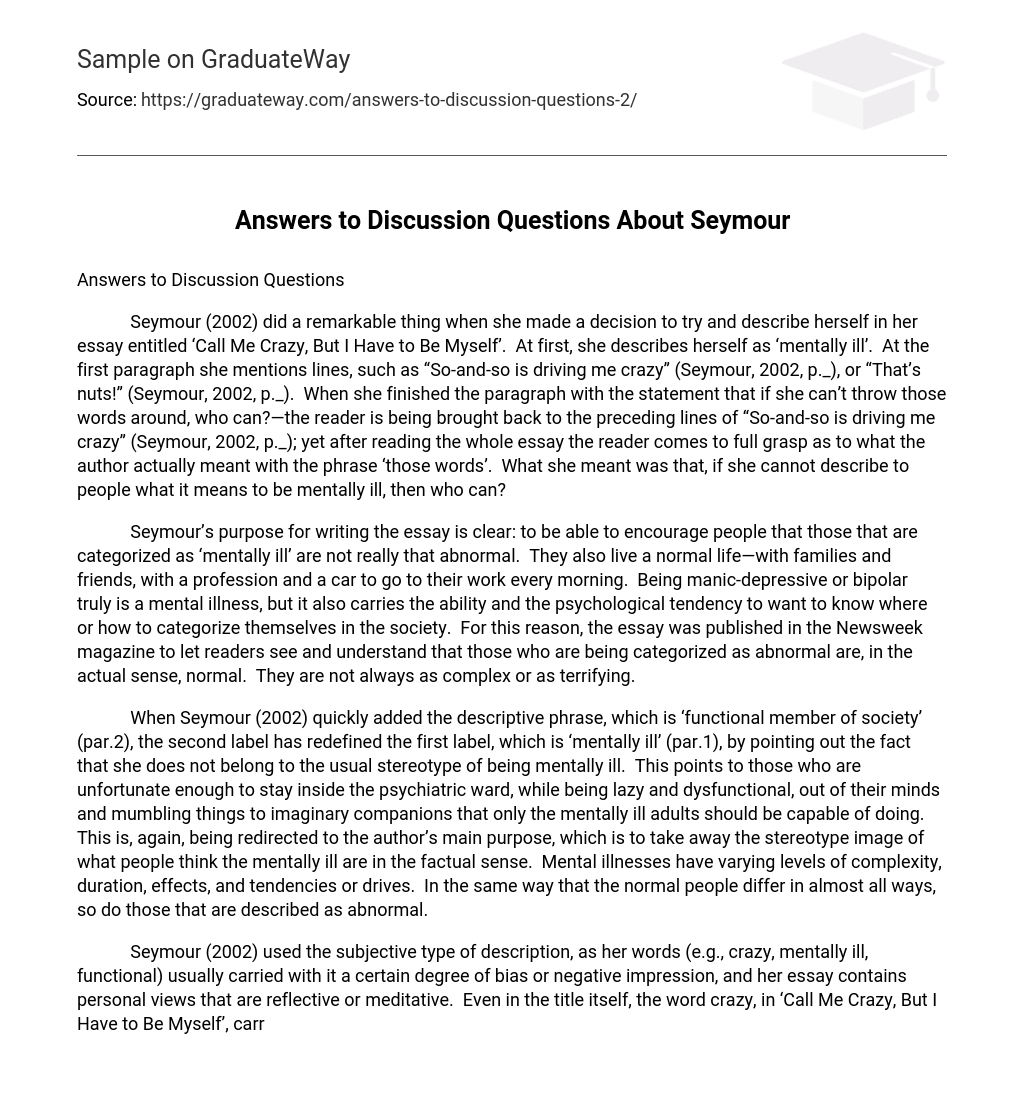Seymour (2002) did a remarkable thing when she made a decision to try and describe herself in her essay entitled ‘Call Me Crazy, But I Have to Be Myself’. At first, she describes herself as ‘mentally ill’. At the first paragraph she mentions lines, such as “So-and-so is driving me crazy” (Seymour, 2002, p.), or “That’s nuts!” (Seymour, 2002, p.).
When she finished the paragraph with the statement that if she can’t throw those words around, who can?—the reader is being brought back to the preceding lines of “So-and-so is driving me crazy” (Seymour, 2002, p.); yet after reading the whole essay the reader comes to full grasp as to what the author actually meant with the phrase ‘those words’. What she meant was that, if she cannot describe to people what it means to be mentally ill, then who can?
Seymour’s purpose for writing the essay is clear: to be able to encourage people that those that are categorized as ‘mentally ill’ are not really that abnormal. They also live a normal life—with families and friends, with a profession and a car to go to their work every morning. Being manic-depressive or bipolar truly is a mental illness, but it also carries the ability and the psychological tendency to want to know where or how to categorize themselves in the society. For this reason, the essay was published in the Newsweek magazine to let readers see and understand that those who are being categorized as abnormal are, in the actual sense, normal. They are not always as complex or as terrifying.
When Seymour (2002) quickly added the descriptive phrase, which is ‘functional member of society’ (par.2), the second label has redefined the first label, which is ‘mentally ill’ (par.1), by pointing out the fact that she does not belong to the usual stereotype of being mentally ill. This points to those who are unfortunate enough to stay inside the psychiatric ward, while being lazy and dysfunctional, out of their minds and mumbling things to imaginary companions that only the mentally ill adults should be capable of doing.
This is, again, being redirected to the author’s main purpose, which is to take away the stereotype image of what people think the mentally ill are in the factual sense. Mental illnesses have varying levels of complexity, duration, effects, and tendencies or drives. In the same way that the normal people differ in almost all ways, so do those that are described as abnormal.
Seymour (2002) used the subjective type of description, as her words (e.g., crazy, mentally ill, functional) usually carried with it a certain degree of bias or negative impression, and her essay contains personal views that are reflective or meditative. Even in the title itself, the word crazy, in ‘Call Me Crazy, But I Have to Be Myself’, carries strong indication that she accepts her being crazy. This is supported by the first paragraph, when she described herself as mentally ill, but then comes to contradict her biased words when she quickly added the phrase that is ‘functional member of society’ in the second paragraph.
The essay appeared to be ironic, since it points to the conclusion that the author is crazy and, at the same time or in another sense, that she is not. As she stated in the essay, “Being a functional member of society and having a mental disorder is an intricate balancing act” (Seymour, 2002, p.). In the same way that the author belongs to both normal and abnormal categories of people, so do ‘crazy’ direct readers to both positive and negative denotations of the word.
Seymour’s description of herself was truly remarkable. In her desire to explain to people the complexity and the miscellany that are attached to the ‘mentally ill’ phrase, she attaches the thought that being crazy is not really that abnormal. Her use of the phrase ‘call me crazy’—found in the title of the piece—was truly biased and very insulting, especially at first glance.
However, after reading the piece, the reader gets to understand more the true attitude of the author: that she intends to accept and face who or how she really is, despite the negativity attached to her and the words being stereotyped. By being true to herself and what she really is, her acceptance has led her to become more functional in the society, such as by helping those that are experiencing what she had gone through in the past. She had integrated both public and private sides of herself… now she’s throwing the words around.
Reference
- Seymour, M. (2002). Call me crazy, but I have to be myself.





